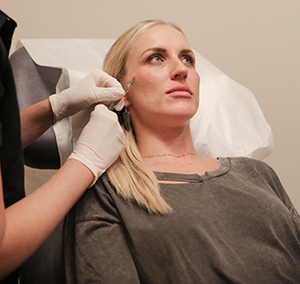The Use of Neuromodulators in the Aesthetic Patient

Last month I shared the similarities and differences between Botox, Dysport and Xeomin (If you missed this post, brush up on the topic by clicking here.) Today, I would like to talk about how I use these products to create results our patients here at MediSpa Maui/The Stolley Center absolutely love. If you find this blog post informative, do share it!
Now, let’s get started. The top 3 injection sites for these products are the frown, the forehead and the squints. A common Botox and Xeomin dose in the frown is 20-25 units. The forehead dose tends to be 6-12 units and the squints tend to be 12-15 units per side. These doses should be multiplied X 3 for Dysport. That is, the Dysport dose is 3 X more than Botox and Xeomin. It should be noted the actual amount of liquid injected is the same. The dose is more of a factor in how a unit is defined at the time research and studies are done, not the actual amount of the product that is injected. Other areas we commonly treat include the lines on the upper nasal region called the “bunny lines”, vertical lip lines around the mouth, the wrinkling in the chin, the muscles that pull the corners of the mouth down and the vertical neck bands that pop out on expression. I also commonly use neuromodulators (NM) to decrease the size of the jaw muscle and to decrease grinding and clenching. Three other ways I use NMs: 1.) To decrease the size of the salivary glands. 2.) To decrease sweating. 3.) To decrease the severity and frequency of migraine headaches.
I consider 2 things when determining the proper cosmetic dose of a neuromodulator. First, how big the muscle is and second, what degree of relaxation my patient wants. If my patient wants the muscle to be completely still and the skin to be wrinkle-free and without movement, I will use a higher dose. If my patient wants some movement and doesn’t mind some wrinkles, but wants them softened, I will use a lighter dose. When it comes to determining the optimal dose for any patient, I consider 2 more aspects of a treatment.
The first is rather obvious. Approximately two weeks after the treatment, I determine if the dose has had the desired effect. Has it relaxed the wrinkles to the degree my patient wants? If not, I consider using more. In rare cases, if the patient feels “too frozen”, I use less the next time. The other aspect of the treatment I consider is how long the treatment lasts. The companies that make Botox, Dysport and Xeomin are allowed to say that they last 3-4 months when injecting a standard dose. For example, the standard dose of Botox is 20 units in the frown. If I use 20 units in someone’s frown and it is working great at 2 weeks but their frown is coming back at 2 months, I will consider bumping that patient up to a higher dose, often 25 units.
Another condition to consider is if my patient has a line at rest (also called a “resting line”). If my patient has a frown that they do not like both when they are frowning but also when they are at rest, that patient may need a higher dose of Botox and they may need some filler placed in the line to obtain the best result. It is advisable to start with the neuromodulator in most cases for various reasons. The most obvious reason is that if the muscle is not relaxed, the filler placed in the resting line will not last as long. One last point, it is recommended that patients space their treatments out every 3-4 months. This is to limit the very unlikely creation of what are known as “neutralizing antibodies”. When proteins such as NMs are injected into our bodies that are made from anything other than our own self, there is always a small risk of creating antibodies. If the antibodies form to the action site of the neuromodulator, it could block the action of the NM. That is, in the example above, the 20 units of Botox would no longer work for that patient. And that failure would likely be to all the three products and would be permanent. To my knowledge, there has only been one reported case of neutralizing antibodies of Botox Cosmetic failure in millions of treatments. But because it is a potential risk, other than an initial “topping off dose” after a patient’s first injection in my office, I do not recommend repeat doses before 3 months. As I mentioned in my previous blog, if a patient wants to have regular treatments at intervals of less than 3 months, I would consider Xeomen for this patient even though the risk of neutralizing antibodies is exquisitely low.
I hope you have enjoyed this discussion of the differences and similarities of Botox, Dysport and Xeomin and how they are used. It is my aim that you come away from this discussion with a bit more education on the topic. My team of expert injectors and I enjoy offering these great products to our patients and I enjoy training the next generation of expert injectors. If you have any questions about how these treatments can help soften your lines and wrinkles, do not hesitate to call us at 808-879-4909 to make an appointment for a consultation.
Thank you,
Brian Stolley, MD








